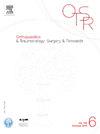Poorer clinical outcomes after THA in patients with a spinal scoliotic deformity: a case-control study of 268 patients assessed with PROMS
IF 2.2
3区 医学
Q2 ORTHOPEDICS
引用次数: 0
Abstract
Introduction
Spinal deformities can lead to specific complications after total hip arthroplasty (THA), such as functional leg length discrepancy due to a fixed pelvic obliquity, as well as an increased risk of prosthetic instability due to a lack of adaptive pelvic mobility, but these issues were not investigated in large comparative series. Therefore a retrospective case-control study was done aiming: 1) to analyze the impact of a preoperative scoliotic deformity on the functional outcomes of patients who underwent THA with a minimum 1-year follow-up, 2) to measure the prevalence of scoliosis in both the case and control groups 3) to screen other factors that may be correlated with poorer clinical outcomes in patients who underwent THA, including age, gender, Body Mass index (BMI), American Society of Anesthesiologists (ASA) score, primary THA etiology and postoperative complication occurrence.
Hypothesis
The presence of scoliosis would have a negative impact on THA outcomes as assessed by PROMs.
Materials and methods
A case-control study was conducted using prospectively collected data including 268 patients who underwent THA between January 2009 and December 2021 through a direct anterior approach by the same senior surgeon. Cases were identified based on a 1-year follow-up modified Harris Hip score (mHHS) lower than 81 while controls were defined as patients with an excellent 1-year follow-up mHHS score (equal to or higher than 81). Three controls were randomly matched with each case based on the surgery period. To assess the impact of a concurrent scoliosis on clinical outcomes, a mathematical univariate and multivariate logistic model was used, including other confounding factors (age, gender, ASA score, BMI, Complication occurrence, etiology), to calculate the adjusted odds-ratio.
Results
In the multivariate analysis, scoliosis was found to be a significant risk factor, with a three-fold higher adjusted odds-ratio of lower mHHS score (adjOR = 3.1; 95 CI:1.4–7, [p < 0.01]). The mean mHHS score was significantly lower in the scoliosis group compared to the non-scoliosis group (77 vs. 84 [p = 0.01]) as well as the mean Oxford Hip Score (36 vs. 43 [p < 0.001]). Among the other assessed risk factors, only the occurence of a postoperative complication was associated with an increased odds ratio of poorer mHHS scores (adjOR = 7.1; 95 CI: 2.78–18.24, [p < 0.001]). The prevalence of scoliosis in our practice was 19%.
Discussion
: Given the prevalence of 19% found in our study, we recommend screening for scoliosis in all patients scheduled for THA. Our results indicate that patients who had scoliosis experienced lower PROMs scores compared to those who had not. Surgeons should consider delivering this information to patients who have scoliosis undergoing THA to mitigate patient dissatisfaction.
Level of evidence
III; retrospective case-control study.
脊柱侧弯畸形患者 THA 术后较差的临床疗效:对 268 例患者进行 PROMS 评估的病例对照研究。
简介:脊柱畸形可导致全髋关节置换术(THA)后的特殊并发症,如固定骨盆倾斜导致的功能性腿长不一致,以及缺乏适应性骨盆活动度导致假体不稳定的风险增加,但这些问题并未在大型对比系列研究中进行调查。因此,我们进行了一项回顾性病例对照研究,旨在1)分析术前脊柱侧弯畸形对至少随访1年的接受THA患者功能预后的影响;2)测量病例组和对照组中脊柱侧弯的发生率;3)筛选可能与接受THA患者较差临床预后相关的其他因素,包括年龄、性别、体重指数(BMI)、美国麻醉医师协会(ASA)评分、原发性THA病因和术后并发症发生率。假设根据PROMs评估,脊柱侧弯的存在会对THA结果产生负面影响:使用前瞻性收集的数据开展了一项病例对照研究,研究对象包括在 2009 年 1 月至 2021 年 12 月期间接受过 THA 手术的 268 名患者,均由同一资深外科医生通过直接前路手术完成。病例的确定依据是随访 1 年的改良哈里斯髋关节评分(mHHS)低于 81 分,而对照组则定义为随访 1 年的 mHHS 评分优秀(等于或高于 81 分)的患者。每个病例根据手术时间随机匹配三个对照组。为了评估并发脊柱侧凸对临床结果的影响,我们使用了数学单变量和多变量逻辑模型,包括其他混杂因素(年龄、性别、ASA评分、体重指数、并发症发生率、病因),计算调整后的几率:结果:在多变量分析中发现,脊柱侧弯是一个重要的风险因素,其 mHHS 评分较低的调整赔率比其他因素高出三倍(adjOR = 3.1; 95 CI:1.4-7, [p 讨论:鉴于我们的研究发现脊柱侧弯的发生率为 19%,我们建议对所有计划接受 THA 的患者进行脊柱侧弯筛查。我们的研究结果表明,与没有脊柱侧弯的患者相比,有脊柱侧弯的患者PROMs评分较低。外科医生应考虑向脊柱侧弯的THA患者提供这一信息,以减少患者的不满:证据等级:III;回顾性病例对照研究。
本文章由计算机程序翻译,如有差异,请以英文原文为准。
求助全文
约1分钟内获得全文
求助全文
来源期刊
CiteScore
5.10
自引率
26.10%
发文量
329
审稿时长
12.5 weeks
期刊介绍:
Orthopaedics & Traumatology: Surgery & Research (OTSR) publishes original scientific work in English related to all domains of orthopaedics. Original articles, Reviews, Technical notes and Concise follow-up of a former OTSR study are published in English in electronic form only and indexed in the main international databases.

 求助内容:
求助内容: 应助结果提醒方式:
应助结果提醒方式:


